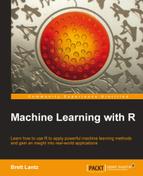- Machine Learning with R
- Table of Contents
- Machine Learning with R
- Credits
- About the Author
- About the Reviewers
- www.PacktPub.com
- Preface
- 1. Introducing Machine Learning
- 2. Managing and Understanding Data
- R data structures
- Vectors
- Factors
- Managing data with R
- Exploring and understanding data
- Exploring the structure of data
- Exploring numeric variables
- Measuring the central tendency – mean and median
- Measuring spread – quartiles and the five-number summary
- Visualizing numeric variables – boxplots
- Visualizing numeric variables – histograms
- Understanding numeric data – uniform and normal distributions
- Measuring spread – variance and standard deviation
- Exploring categorical variables
- Exploring relationships between variables
- Summary
- 3. Lazy Learning – Classification Using Nearest Neighbors
- 4. Probabilistic Learning – Classification Using Naive Bayes
- Understanding naive Bayes
- Example – filtering mobile phone spam with the naive Bayes algorithm
- Summary
- 5. Divide and Conquer – Classification Using Decision Trees and Rules
- Understanding decision trees
- Example – identifying risky bank loans using C5.0 decision trees
- Understanding classification rules
- Example – identifying poisonous mushrooms with rule learners
- Summary
- 6. Forecasting Numeric Data – Regression Methods
- Understanding regression
- Example – predicting medical expenses using linear regression
- Understanding regression trees and model trees
- Example – estimating the quality of wines with regression trees and model trees
- Summary
- 7. Black Box Methods – Neural Networks and Support Vector Machines
- 8. Finding Patterns – Market Basket Analysis Using Association Rules
- 9. Finding Groups of Data – Clustering with k-means
- Understanding clustering
- Clustering as a machine learning task
- The k-means algorithm for clustering
- Finding teen market segments using k-means clustering
- Step 1 – collecting data
- Step 2 – exploring and preparing the data
- Step 3 – training a model on the data
- Step 4 – evaluating model performance
- Step 5 – improving model performance
- Summary
- Understanding clustering
- 10. Evaluating Model Performance
- 11. Improving Model Performance
- 12. Specialized Machine Learning Topics
- Index
In this chapter, we learned about classification using naive Bayes. This algorithm constructs tables of probabilities that are used to estimate the likelihood that new examples belong to various classes. The probabilities are calculated using a formula known as Bayes' theorem, which specifies how dependent events are related. Although Bayes' theorem can be computationally expensive to process, a simplified version that makes so-called "naive" assumptions about the independence of features is capable of being used with extremely large datasets.
The naive Bayes classifier is often used for text classification. To illustrate its effectiveness, we employed naive Bayes on a classification task involving filtering spam SMS messages. Preparing the text data for analysis required the use of specialized R packages for text processing and visualization. Ultimately, the model was able to classify nearly 98 percent of all SMS messages correctly as spam or ham.
In the next chapter, we will examine a set of two more machine learning methods. Each performs classification by partitioning data into groups of similar values.
-
No Comment
